The Stackable Beaker Market is estimated to be valued at USD 6.7 billion in 2025 and is projected to reach USD 10.0 billion by 2035, registering a compound annual growth rate (CAGR) of 4.1% over the forecast period.
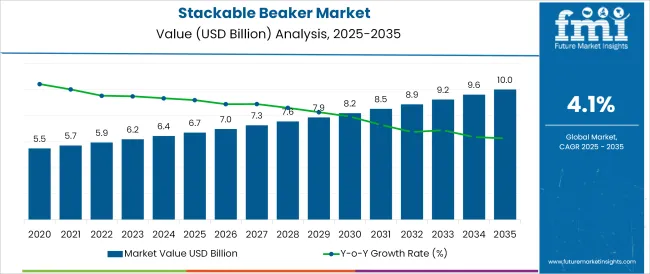
The stackable beaker market is being shaped by laboratory efficiency requirements, space optimization trends, and rising adoption of standardized labware solutions across educational and research institutions. Demand has been fuelled by the increasing need for robust materials capable of withstanding frequent thermal cycling, which aligns with evolving laboratory protocols.
Enhanced manufacturing techniques-such as precision molding and durable polymer formulations-have enabled stackable beakers to deliver both thermal resilience and ease of storage within confined lab spaces. Environmental and cost consciousness has encouraged institutions to adopt reusable, load-optimized glass or polymer beakers to reduce material waste.
Regulatory emphasis on laboratory safety and compatibility with a broader range of chemicals has further reinforced the suitability of specialized materials and design features. Going forward, the market is expected to see steady growth, driven by innovation in material engineering, modular labware systems, and convenience-driven design tailored for education, quality control, and research workflows.
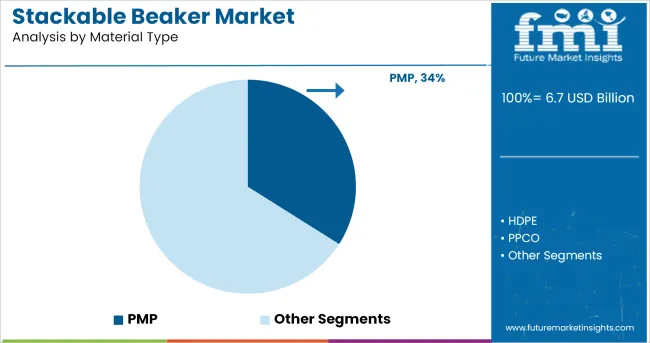
It is observed that PMP (polymethylpentene) holds 34.0% of total market revenue, establishing it as the leading material type in the stackable beaker segment. This dominance is attributed to PMP’s lightweight nature, high chemical resistance, and thermal stability, which suit repeated autoclaving and chemical exposure.
Its optical clarity enhances visibility of solutions, aiding precise measurement and observation. Furthermore, PMP has been favored due to its propensity for molding into stackable forms, providing enhanced storage efficiency and breakage resistance compared to glass counterparts.
This combination of performance, durability, and space optimization has led to its wide adoption in institutional and industrial laboratories, reinforcing its leadership in the material type category.
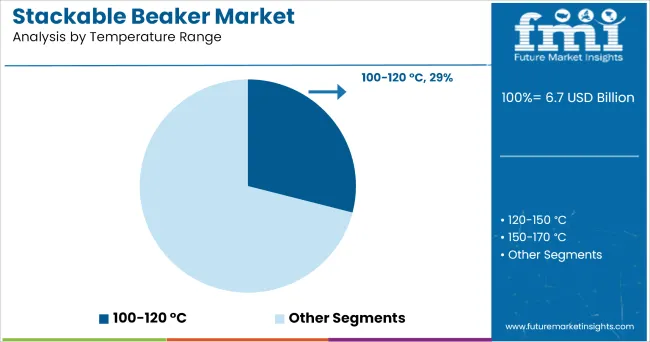
It is noted that the 100-*120 °C temperature range captures 29.0% of the market revenue, making it the predominant performance bracket. This can be attributed to the prevalence of routine laboratory procedures-such as heating, sterilization, and boiling-that fall within this thermal envelope.
Most educational and quality-control applications require beakers capable of sustaining moderate heat without deformation or compromise to material integrity. The 100-120 °C range also aligns with the thermal resistance of commonly used polymers like PMP and borosilicate alternatives.
Consequently, it has been observed that buyers prioritize beakers rated for this range to ensure reliability, safety, and operational consistency across labs, reinforcing the segment’s leading market position.

It has been observed that education laboratories account for 36.0% of market revenue, marking them as the largest application segment. This is due to large-scale procurement by schools, universities, and training centres prioritizing straightforward, durable, and stackable beakers.
The modularity of stackable designs optimizes storage space within crowded lab facilities, while the use of PMP and moderate heating capabilities ensure user safety and repeated use. Additionally, standard classroom protocols require chemical compatibility and visible measurement scales-both of which are well-supported by these beakers.
Bulk purchasing of stackable PMP beakers rated for 100-120 °C has become standard practice. As a result, the education sector continues to anchor the market, driven by functional need, cost-efficiency, and safety requirements.
The characteristics such as high Chemical resistance, higher durability, High temperature operability and easily stackable design that ensures efficient use of work space have advocated the use of Stackable Beaker amongst the end users. Chemical testing applications for healthcare and Lifesciences laboratory work is projected to be a lucrative avenue for global and regional manufacturers.
Sales of Stackable Beaker in scientific laboratories is anticipated to grow higher due to enhancement in research and development activities for various developments and innovations. Along with that educational organizations are expected to raise the sales growth in upcoming period due to development of high quality educational Laboratories in various regions.
These Beakers are suitable to be used while creating various chemical experiments under controlled temperature, along with that these are not made of glass which makes them more durable for different work condition. These beakers can be easily stored owing to their design which allows to stack them which also solve the problem for storage space.
In addition to that, adoption of these beakers is increasing in industrial Sector. The Industrial Sector is witnessing an evolution in terms of product development and production methods owing to technology advancements and requirements for new and innovative products in the market. Subsequently, boosting the growth in demand for Stackable Beaker across the globe.
This has also had a substantial effect on manufacturing and sales activities on the back of nationwide lockdowns and transport regulations across the globe.
However, with resuming manufacturing facilities and supply chains recommencing the demand for Stackable Beaker to witness sharp recovery post the containment of pandemic.
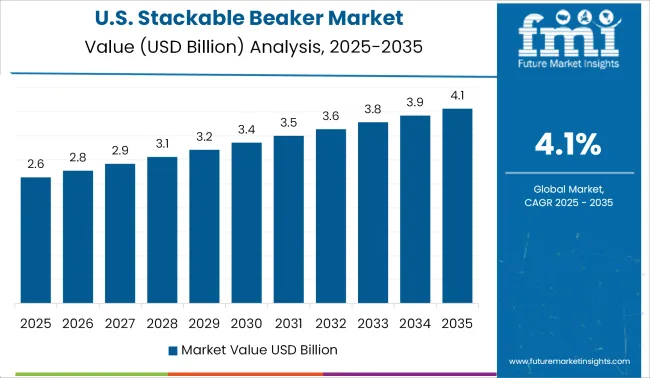
North America is estimated to be one of the prominent markets globally where the regional market is set to account for substantial share in the global market during the assessment period 2025 to 2035.
The substantial investments in medical & healthcare technologies coupled with developments in chemical industry is likely to propel demand during the forecast period. The demand generation is expected each from USA and Canada in a healthy extent
Demand for Stackable Beaker in East Asia have been expanding significantly over the recent years and this trend is projected to persist over the coming years. These is attributable to strategic developments by market players for improving market presence in the region.
Furthermore, emerging economies including China and Japan have been major markets for healthcare, science and technical education. These factors are expected to create positive prospects for the market growth in the region.
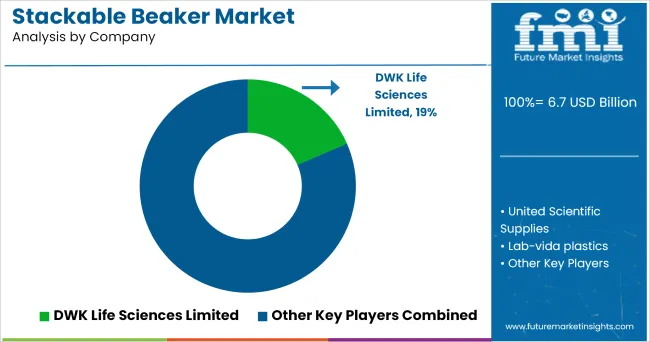
Some of the leading manufacturers and suppliers of Stackable Beaker include
The market of Stackable beaker is distributed amongst many small level local players which are frequently creating collaborations with end users to get more sales. Along with that some of global players are continuously focusing on acquiring local players and suppliers to enhance their market channel and enhance their revenue generation.
The report is a compilation of first-hand information, qualitative and quantitative assessment by industry analysts, inputs from industry experts and industry participants across the value chain. The report provides in-depth analysis of parent market trends, macro-economic indicators and governing factors along with market attractiveness as per segments. The report also maps the qualitative impact of various market factors on market segments and geographies.
The global stackable beaker market is estimated to be valued at USD 6.7 billion in 2025.
The market size for the stackable beaker market is projected to reach USD 10.0 billion by 2035.
The stackable beaker market is expected to grow at a 4.1% CAGR between 2025 and 2035.
The key product types in stackable beaker market are pmp, hdpe, ppco and pfa.
In terms of temperature range, 100-120 °c segment to command 29.0% share in the stackable beaker market in 2025.






Full Research Suite comprises of:
Market outlook & trends analysis
Interviews & case studies
Strategic recommendations
Vendor profiles & capabilities analysis
5-year forecasts
8 regions and 60+ country-level data splits
Market segment data splits
12 months of continuous data updates
DELIVERED AS:
PDF EXCEL ONLINE
Stackable Plastic Trays Market Size, Share & Forecast 2025 to 2035
Stackable Container Market Size and Share Forecast Outlook 2025 to 2035
ESD Stackable Box Market Trends & Industry Analysis 2024-2034
Griffin Beaker Market Size and Share Forecast Outlook 2025 to 2035
Industry Share Analysis for Griffin Beaker Manufacturers

Thank you!
You will receive an email from our Business Development Manager. Please be sure to check your SPAM/JUNK folder too.
Chat With
MaRIA